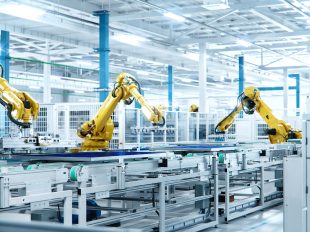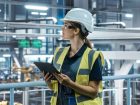The European Agency for Occupational Safety and Health (EU-OSHA) has published research that focuses on the automation of tasks using artificial intelligence (AI) and advanced robotics and how that automation affects occupational safety and health (OSH).
It explains how these technologies can improve the quality of work, but may also require more information on their management. The paper also cites a series of case studies carried out by EU-OSHA, which analyse the practical implementation and success factors of these systems, comparing them with the existing scientific literature.
Automation for robotics: innovative technologies
In all the case studies, a number of different technologies used to automate physical and cognitive tasks were analysed. The most important finding is that the same type of technology can be used to automate different tasks in very different environments.
Single or double-arm multiaxial robots (cobots)
Lightweight robotic systems with multiple axes and single or double arms are among the most commonly used advanced robots. Cobots, which differ from traditional robots, can interact with human workers without safety barriers, performing simple and repetitive tasks, while humans deal with more precise and cognitive ones.
Depending on the degree of standardisation and the autonomy of the work systems, there are advantages and disadvantages to using cobots. Humans and robots can cooperate, standardising tasks considerably, but it is much more difficult for them to collaborate. To date, the main form of interaction is coexistence, in which they do not operate on the same object simultaneously or in sequence.
AGV – Mobile Robots
AGVs (automated guided vehicles) or mobile robots are a type of advanced robot that can transport objects in a workspace shared with humans, replacing, for example, forklifts and their operator (forklift driver). AGVs can navigate autonomously by following coded paths or sensors.
The integration with software based on artificial intelligence can optimise the distribution/retrieval of goods. AGVs can be used in almost all sectors and work environments; what makes them different from other cobots is their specific task, i.e. moving, especially in defined and repetitive routes (e.g. the end of a production line). They are a type of technology that has been tested very well in the last twenty years.
Systems based on artificial intelligence for visual input processing
Systems based on artificial intelligence (AI) process visual input and generate output for the operator. These systems can be used in different work environments, such as medicine, construction and manufacturing, to perform visual analysis activities.
It is important to have good training data for these systems, which learn quickly. Considering this and other reasons, it is easy to understand why customised solutions are more common than commercial products. These systems are not equipped with self-learning under normal operating conditions, but are updated periodically to improve accuracy.
AI-robot hybrid systems
Combinations of AI-based software and advanced robotic devices are being used more and more. The combination of the two can lead to more advanced and autonomous robotic systems.
Many advanced robots do not yet use true AI-based software, but rely instead on traditionally programmed software. Although the difference between the two types of systems may not be apparent to the end user today, it will inevitably become clearer as the performance, capabilities and fluidity of the systems increase.
Hybrids with AI-based software and robotic automation are still rare in real-world applications, but there are several types of advanced robotics that can interact with humans according to purpose and mobility.
Integration and considerations
The results of 11 case studies that examine the use of different advanced technologies, both in robotics and artificial intelligence (AI), and their impact on occupational safety and health (OSH), show interesting data to reflect upon.
The physical impact of the system is the most relevant for OSH, followed by organisational changes. The psychosocial impact is the least common. The paper underlines the importance of being aware of the type of technology we interact with and how the combinations of AI and robotics can lead to more advanced and autonomous systems.
It is simply more effective and profitable in most cases to automate routine tasks before tackling more complex non-routine tasks. Moreover, non-routine tasks might be difficult for a software system to solve, but relatively simple for a human worker.
The case studies include a mixture of systems that replace human work and assist workers. For example, a case study shows how a system based on artificial intelligence (AI) can enable a robotic arm to perform a sorting task.
The novelty is that the AI does not control the movement of the arm, but only the inspection of the parts, i.e. the system performs a routine activity related to the objects, effectively replacing a person performing that task. This is a classic example of combined AI and robotics; most of the activities in the workplace can be divided into secondary activities with different degrees of physical and cognitive qualities.
Another very interesting case study describes how the use of systems based on artificial intelligence (AI) and external robotic add-ons can automate the excavation process in a number of construction sites. The system can operate completely autonomously or with human intervention, depending on the complexity of the environment, offering the worker significant control over the degree of automation. It can be used for multiple construction sites.
Impacts of robotics and AI on occupational safety
The impact of the system on the three dimensions of occupational safety and health (OSH), i.e. physical, organisational and psychosocial, can be important and the three aspects can be influenced by every type of innovation. Clearly, the physical impact is the most evident and the most affected, because almost all systems automate physical tasks, which become fewer or disappear altogether.
OSH-related organisational changes are another much-mentioned group. Systems that reduce the night shift have significant impacts on the organisation of the work itself. However, there is a considerable discrepancy between current legislation and technological capabilities. Currently, the regulations in force in some cases limit the capabilities of the systems, especially in terms of capacity and strength, but also in terms of speed.
Unlike what many people think today, the psychosocial impact is the least common. In the collective imagination, these systems create stress and fear. Workers often oppose the automation of tasks through advanced robotics and AI-based systems because they fear being replaced by technology.
In only one case was fear for personal physical safety the underlying reason for opposition, and the fear was rooted in the lack of understanding of the new system’s safety features. The study also shows more comforting data.
Technology and employment concerns
The fear of job loss remains but the impact is very variable: it can be positive (increased social interaction, in contrast to social isolation; reduced physical fatigue and cognitive load) or negative (fear of job loss or lack of trust in the system). An interesting fact is that these systems tend to be less evident during daily work; AI-based systems in particular are not usually physically visible, unlike robotic systems. This makes it much easier to get used to the system and does not trigger negative associations.
It is therefore necessary and important to consider the impacts and effects of advanced technologies (related to both robotics and AI) on the psychosocial factors of occupational safety and health (OSH).
Organisations are beginning to be fully aware of the positive or negative impacts these systems can have on stress, confidence, fear of job loss and the social interaction of workers. Neglecting these aspects could lead to physical risks or missed opportunities to improve OSH.
The need for comprehensive risk assessment tools
The need for comprehensive risk assessment tools that reflect the current capabilities and limitations of today’s technologies has been highlighted. Organisations that use robotic and/or AI systems extensively should evaluate the impact of advanced technologies on all three dimensions of OSH: physical, organisational and psychosocial. Finally, there remains a very wide range of combinations of technologies and activities that have not been covered by the case studies and that could be the subject of future research.
All case studies indicate that task automation through advanced robotics and AI-based systems will continue to develop.
Advanced robotics and AI-based systems offer new and unique solutions to the challenges of automating every current and future activity. Being more flexible and autonomous than any other type of previous technology, they can automate tasks that were previously too complex for machines, but that are boring, dangerous or, above all, harmful to humans.
This modern technology can not only increase work efficiency, but also increasingly promote OSH, offering companies a double incentive to use it. In general, businesses that have implemented systems based on artificial intelligence have not encountered major problems.
The limits are more to be found in the costs that still remain very high, but it is reasonable to think that their large-scale development will lead to prices falling. In terms of OSH, the most challenging aspect of implementation is still the alignment of the technology, of the task to be automated, with the current legislation and security requirements.
Involving workers in the implementation of new technologies
Actively involving workers during the implementation process can contribute to successfully implementing a new technology in the workplace. Workers who are involved in the process are more familiar with the technology, which also reduces resistance to automation. In the case studies, companies that involved workers early reported less opposition to automation among their employees. The general trend is to improve the skills of workers and provide them with both the training necessary to use the new technology and the possible skills that will remain relevant throughout their career.




